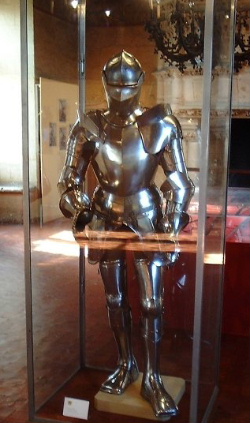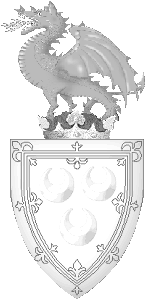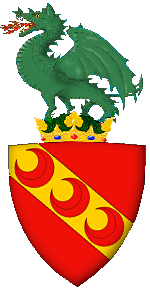|

In
heraldry, a crescent is displayed with the horns directed upward and is often used as a mark of
cadency to distinguish a second son and his descendants.
Gules is the heraldic name for the colour red,
and it ranks highest
among the colours. It is indicated in seals and engraved figures of escutcheons
by parallel vertical lines. Because of its heraldic connection, the word gules is
used poetically for a red colour or that which is red.
In the ancient Carolingian
bloodline the Setons were senior representatives through their descent from Lambert de Lens, 2nd son of Count Eustace I of Boulogne,
of the five Eustace fame.
Hence the meaning of the three crescents in the Seton Arms, signifying descent
from the second son of the House of Boulogne.
Adding to this Royal connection,
Lambert married as his second wife Adele, sister
of Duke William of Normandy, later to become William I of England. Lambert's father, Eustace I's descent was from the Counts of Ponthieu,
who came from Berthe, daughter of Emperor Charles I, or Charlemagne. Eustace's wife
was the heiress of Charles, Duke of Lower Lorraine, the last direct male heir of Charles I.
Both Eustace I and his wife were descended in a multiplicity of the male and female
lines of the French dynasty known as the Carolingians, descended from
Charles I, King of France and Holy Roman Emperor who died in
A.D. 814.
Seier
de Seton (de Lens, in Flanders)
was the eldest son of Count Lambert de Lens. He
founded the family of Seton and was
granted lands in East Lothian by King Malcolm III, which were
later named after the family's estate holdings in Northumberland
named after the sea-town of Seaton-Staithes, later to be known in Scotland as SETON.
Later, Lambert's daughter
Judith's second marriage, was to David I as his second wife,
and Seier and Walter de Lens/de Seton were her half-brothers. From King David I, Judith was the
mother of Scotland's Queen Maud. Later further adding to the family's
royal blood and ties, Sir Christopher Seton married Lady Christina Bruce, sister of King
Robert I, giving
his Seton descendants further ties to the Royal Family of
Scotland. A double tressure was added to the Seton Arms after 1314 by King Robert I to
recognize the Setons Royal lineage.
| 

